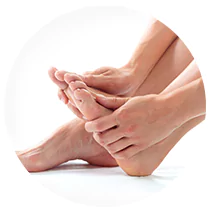Foot Pain Treatment
Overview
Plantar Plate Disruption

Adventitial Bursitis
Synovitis
Morton’s Neuroma/ intermetatarsal bursitis
Morton’s Neuroma or More Appropriately Entrapment Syndrome
Common causes of forefoot pain include joint inflammation (arthritis, capsulitis & synovitis), plantar plate tears, tendinosis (“tendinitis”), bursitis and Morton’s neuroma. A Morton’s neuroma occurs when scar tissue builds upon a nerve in between the toes known as the interdigital nerve (nerve between the digits, or toes). In Morton’s entrapment, the common plantar digital nerve, also referred to as the intermetatarsal nerve, gets compressed from forefoot plantar pressure in the late midstance and propulsive phases of gait against the distal margin of the transverse intermetatarsal ligament This is most frequently seen in women and is and is attributed to high heeled shoes. The pain is often severe and has an electric shock character to it. Common symptom descriptions include some or all of the following: “It feels like my sock is wadded up under my foot,” “cramping,” “numbness,” “burning,” “radiating sensations into the adjacent toes,” “the inability to walk barefoot on a hard floor,” and “tingling.” Others describe a feeling like having a pebble in their shoe or walking on razor blades.
Symptoms includes: pain on weight bearing, frequently after only a short time. The nature of the pain varies widely among individuals. Some people experience shooting pain affecting the contiguous halves of two toes. Burning, numbness, and paresthesia may also be experienced. Usually, patients with Morton’s entrapment demonstrate pain with plantar palpation of the interspace between the metatarsal heads.

Receive Effective Treatment For Your Foot Pain
Radiofrequency
The RF Procedure
A medical provider experienced in interventional procedures performs Radiofrequency ablation. The patient is placed in an appropriate position for the procedure; a diathermy pad is placed on the thigh and the injection site cleansed. Pain relief is achieved by injecting a local anesthetic around the nerve that is responsible for the patient’s pain. Once the nerve and area is anaesthetized (numbed), a fine needle is positioned in proximity to the nerve, with the position of which confirmed by imaging guidance (ultrasound or fluoroscopy).
A thin probe is then passed through the needle, which is connected to a generator that results in radiofrequency energy passing through the probe, resulting in heating of the probe tip. The result of this heat is to destroy the targeted nerve and therefore disrupting the ability of the nerve to transmit pain signals. Finally, long-term local anesthetic and cortisone are injected around the treated nerve in order to minimize discomfort, which may arise following the treatment. Treatment via RFA takes approximately 30 minutes. Further time spent at the clinic for post-procedure recovery may be suggested, depending on the exact nature of a patient’s condition. Ultrasound-guided RFA has successfully alleviated patients’ symptoms of Morton’s neuroma/ entrapment in >85% of cases. Less than 10% of patients progress to surgical intervention, such as endoscopic plantar fasciotomy.
Endoscopic Plantar Fasciotomy
EPF is an outpatient procedure. It takes about an hour to perform, and is be done at a hospital or a same-day surgical facility. Using special instrumentation we release the inside band of the plantar fascia responsible for causing your pain. After the procedure, you’ll be taken to a recovery area. As your foot heals, new tissue fills in the gap where the fascia was cut. This lengthens the fascia and reduces strain during foot movement. For best results, see your doctor as directed during the next few weeks or months. Physical therapy or stretching exercises are often prescribed to improve recovery. Wearing shoes with good support is essential for your long-term recovery.
